











germinalamenity.com Knowledge, advice and sustainable products Your climate smart partner Ask for Germinal
Contents
Introduction
Golf mixtures
Grade ‘A’ golf mixtures
Bentgrasses
A27 All Fescue
Sport mixtures
Grade ‘A’ sport mixtures
Landscaping mixtures
Grade ‘A’ landscaping mixtures
Wildflowers
Wild sustainable beauty
Urban Meadows
RE range
Irish mixtures
Fertilisers
Specialist fertilisers
Slow release fertilisers
Liquid fertilisers
Seaweed based feeds
Compound granular fertilisers
Territory map
01 02-11 03-04 05-10 11 12-14 13-14 15-17 16-17 18-27 19 20-22 23-25 26-27 28-36 29 30-31 32-33 34 35-36 37
Climate change needs climate smart solutions
Welcome to the 2024 Germinal Amenity product catalogue.
You will find that our core range of grass seed includes mixtures for the entire sports sector, from golf courses, racecourses and tennis courts to cricket, football and rugby pitches. You can also explore solutions for both general and specialist landscaping projects.
As our industry moves towards more sustainable practices, we continue to focus on environmentally enhanced green spaces with our climate smart solutions such as Germinal DoubleRoot hybrid clovers which are a natural source of nitrogen, improve soil structure and can outperform traditional clovers by persisting through drought and cold weather stress. AberLasting is a DoubleRoot hybrid clover variety and is found in our AberSustain and A18 mixtures.
Increasing biodiversity is also fundamental to supporting ecosystem habitats and Germinal’s range of wildflower mixtures are formulated to attract insects and pollinators with products to suit landscape architects, groundsmen and greenkeepers.

In 2022, we launched our innovative Proactive Seeding programme, a seasonal overseeding approach which has now been widely adopted as a sustainable best practice by many top greenkeepers. This increases the percentage of desirable grass species that can better withstand disease and extreme weather conditions. We’ll continue to spread the message.
This year, we also welcomed Graham Parker as our new Technical Sales Representative for Ireland. With more than two decades of experience in the golf, sports and landscape sectors in Ireland and England, Graham’s extensive knowledge of the industry’s challenges and requirements makes him a valuable asset to our team.
You can connect with our technical sales representatives by visiting , emailing expert@germinalamenity.com 01522 868714 IRE: +353 (0) 87 608 6048
01
Introduction
Golf mixtures

02
A5 Cricket, Tennis and Tees
60% ESCAPADE (Perennial Ryegrass) 40% CABRIO (Ultrafine Perennial Ryegrass)
The original and still the best, A5 is unsurpassed for fineness of leaf and overall quality of varieties.
Escapade sports a 7.9 fineness of leaf score when mown at 10-15mm and is the perfect companion for Cabrio, which is rated 8.5 as the highest fineness score on the 2024 BSPB list for summer sports.
Cabrio is one of the top perennial ryegrass variety for fineness of leaf when mown at 5-7mm, scoring 8.0 and making A5 a fine mixture under pressure.
• Contains Cabrio, the most fine leaved perennial ryegrass currently available
• Quick to establish
• Hard wearing
• High density ground cover
• Superior rooting
Sowing rate 35g/m2 (350kg/ha)
Overseeding rate 20g/m2 (200kg/ha)
Cutting height Down to 4mm
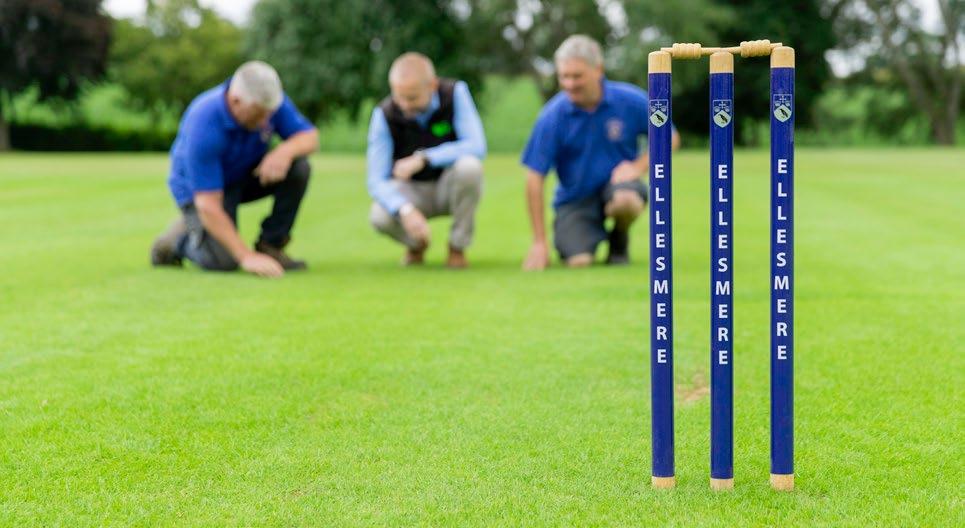
03
“Our end-of-season renovation is weather dependent. We spike to 100mm and then scarify four ways. We then spike to 25mm, apply pre-seed fertiliser, top dress and then drag mat and brush”
Ian Morris Head Groundsman, Ellesmere College
Scan or click here for more information on our golf mixtures. germinalamenity.com Golf mixtures
More Grade ‘A’
golf mixtures
A8
Ultrafine Ryegreens
A10
Golf Tees and Divot Repairs
A11
Golf Greens
A12
Golf Fairways
A13
Golf Roughs and Habitat Areas
A27
Golf All Fescue
A28
Ultrafine Ryegolf
A29
Cold Divot Mix
A31
Supreme Tees
A32
Ecological Roughs Mixture
A33
Maxi Bent Golf Greens
A34
Fescue Fairways and Surrounds
Sowing rate:
20g/m2 (200kg/ha)
35g/m2 (350kg/ha)
35g/m2 (350kg/ha)
35g/m2 (350kg/ha)
20g/m2 (200kg/ha)
35g/m2 (350kg/ha)
35g/m2 (350kg/ha)
35g/m2 (350kg/ha)
10-15g/m2 (100-150kg/ha)
20g/m2 (200kg/ha)
20g/m2 (200kg/ha)
35g/m2 (350kg/ha)
Overseeding rate:
10-15g/m2 (100-150kg/ha)
20g/m2 (200kg/ha)
20g/m2 (200kg/ha)
20g/m2 (200kg/ha)
Cutting height:
Down to 3mm
Down to 6-7mm
Down to 3mm
Down to 15mm
20g/m2 (200kg/ha)
20g/m2 (200kg/ha)
20g/m2 (200kg/ha)
As desired
Down to 5mm for greens, 15mm for fairways and tees
Down to 6-7mm
10-15g/m2 (100-150kg/ha)
20g/m2 (200kg/ha)
Down to 3mm
As desired
Down to 3mm
Down to 5mm
04
n/a n/a n/a
n/a
mixtures
Golf
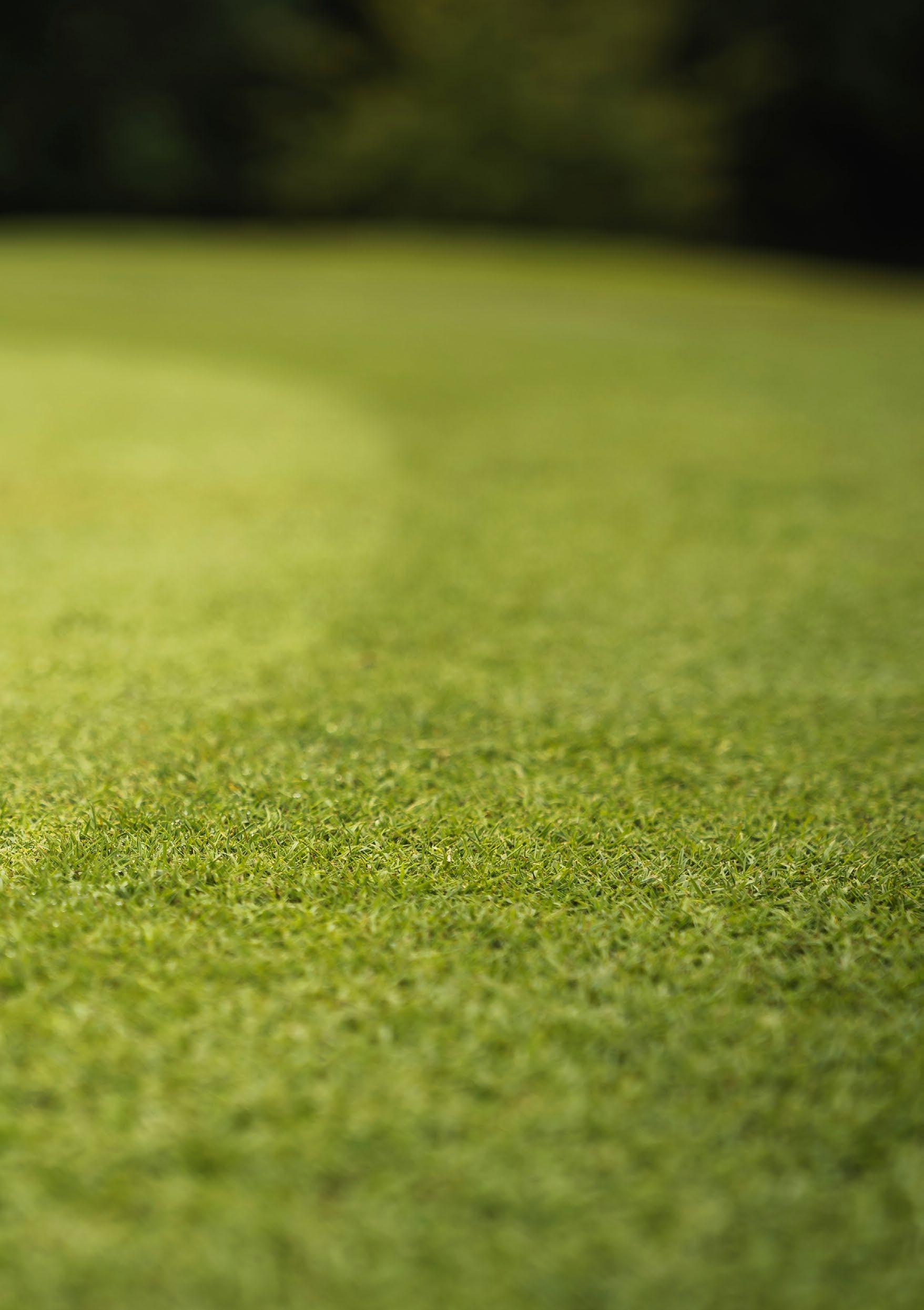
Variety matters:
Choose the UK’s top creeping bents
When Germinal introduced 007 DSB to the UK, we were questioned by greenkeepers and agronomists who believed that all creeping bentgrasses required high inputs (especially nitrogen (N) and water) to succeed.
But the success and simple management of 007 DSB and more recently top-rated Tour Pro (GDE) have shattered the input concerns associated with modern creeping bentgrasses. Adopters in the UK have reported significantly lower nitrogen and water requirements than anticipated, with excellent turf quality maintained using just 50kg of N per hectare. These qualities make them well-suited for typical UK greenkeeping practices.
Greenkeepers can leverage the high shoot density of 007 DSB and Tour Pro (GDE) without concerns about encouraging Poa annua. Both varieties rate strongly in National Turfgrass Evaluation Program (NTEP) trials for resistance to Fusarium, Anthracnose and Dollar Spot. And Tour Pro (GDE) is even more tolerant of drought conditions – helping greenkeepers maintain quality putting surfaces while placing Poa annua under significant stress.
While the tide has turned and many UK greenkeepers are now using these exceptional creeping bentgrass varieties to outcompete Poa annua and develop disease-free greens with exceptional playability, pretenders have arrived. But it’s crucial to recognise that the strength of these varieties lies in their ability to thrive in conditions unfavourable to Poa annua. Older, lower-rated varieties demand higher inputs, inadvertently benefiting Poa annua. So, when choosing seed, remember the variety matters and talk to your local Germinal representative.
05
ForeFront Greens
ForeFront Greens
15% ABERREGAL (Browntop Bent)
20% ABERROYAL (Browntop Bent)
25% MUSKET (Browntop Bent)
20% 007 DSB (Creeping Bent)
20% TOUR PRO (GDE) (Creeping Bent)
• Tour Pro (GDE), the UK’s top-rated creeping bent
• Suitable for soil or sand-based greens
• Enhanced resistance to Red Thread and Fusarium
• Superb stress resistance
• Impressive year-round green colour
• Excellent shoot density and fineness of leaf
Combining the proven performance of our AberMajesty browntop bentgrass blend with the best creeping bents ensures ForeFront Greens delivers the highest levels of disease and stress resistance.
With excellent shoot density, fineness of leaf and unrivalled winter and summer greenness, ForeFront Greens is the ideal mixture for better greens.
Sowing rate: 8-12g/m2 (80 to 120kg/ha)
Overseeding rate: 5-8g/m2 (50-80kg/ha)
Cutting height: Down to 3mm

06
NEW for 2024
Golf mixtures
“This is to try and get finer and more disease-resistant grass species into our greens that can help out-compete Poa annua and tie in with my sustainable management approach."
Iain Marshall Head Greenkeeper, West Lothian Golf Club
Tour Pro (GDE)
Tour Pro (GDE) is the latest creeping bent to join Germinal’s bentgrass portfolio.
After excelling in the National Turfgrass Evaluation Program (NTEP) in the United States, Tour Pro (GDE) is now the highest-rated creeping bentgrass on table G1 of the 2024 BSPB list.
The low input requirement mirrors 007 DSB, enabling greenkeepers to outcompete Poa annua by using management strategies that place Poa under stress. This allows the natural attributes of Tour Pro (GDE) and 007 DSB to gain the upper hand and dominate the sward.
007 DSB Creeping Bent
007 DSB has an unrivalled reputation worldwide.
Bred in the US using 24 parent plants, this genetic diversity ensures good disease resistance, especially against Anthracnose, Fusarium, Snow Mould and Dollar Spot.
This most crucial of traits is coupled with an extremely prostrate growth habit, high shoot density and good wear tolerance in a wide range of conditions, including cold climates and drought susceptible regions. 007 DSB has won plaudits wherever it has been used, including Ryder Cup and US Open courses, and the PGA Masters at Wentworth.
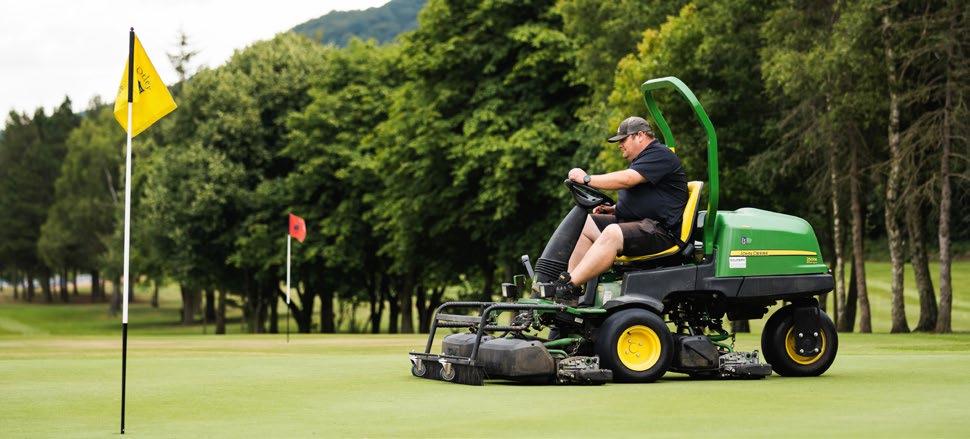
07 Golf mixtures
“The reduced nutrition that’s required, the fact that 007 looks after itself, and especially with the ups and downs of the weather – it can handle variations in temperatures.”
Phil Dodds Golf Course Manager, Otley Golf Club
Tour Leader
Creeping Bent Blend
50% 007 DSB (Creeping Bent)
50% TOUR PRO (GDE) (Creeping Bent)
• Tour Pro (GDE), the UK’s top-rated creeping bent
• Superb Dollar Spot, Anthracnose, Fusarium and Brown Patch resistance
• Adaptable to all UK climates
• Tolerant of close mowing regimes (as low as 3mm)
• Low seedling mortality rates vs. browntops and Fescues, resulting in faster species conversion away from Poa annua
• Tolerant of drought conditions
• Sustainable input requirement: UK users average 92kg N per annum with reduced chemical usage
Tour Leader is a landmark mixture in the evolution of creeping bentgrass products. This exceptional blend sets the bar high with unrivalled performance, seasonal adaptability, high disease resistance and vivid colour retention.
Combining 007 DSB and Tour Pro (GDE), the number-one-rated creeping bent for 2024, this mixture is an all-round leader.

08
Golf mixtures
Climate smart greens
By pairing the drought tolerance and wear resistance of Tour Pro (GDE) with the cold weather tolerance and sustainability of 007 DSB, we have created a mixture with genetic diversity to keep greens in good condition all year round, irrespective of what the weather might throw at them.
With the UK’s variable weather patterns ensuring no two seasons are the same, flexibility makes Tour Leader the ideal overseeding and reseeding mixture for modern greens.
Sowing rate: 8-12g/m2 (80 to 120kg/ha)
Overseeding rate: 5-8g/m2 (50-80kg/ha)
Cutting height: Down to 2.5mm
Full results can found in Turfgrass Seed 2024 table G1
09 Creeping Bent Shoot density Visual merit Mean Fineness of leaf Resistance to red thread Winter greeness Summer greeness UK agent Tour Pro (GDE) 6.6 7.0 6.8 6.6 - 5.4 5.3 G Riptide 6.6 6.8 6.7 6.7 - 5.8 5.0 ICL 007 DSB 6.3 6.5 6.4 6.3 5.9 6.9 5.4 G
Golf mixtures

AberMajesty Browntop Bent Blend
20% ABERROYAL (Browntop Bent)
35% ABERREGAL (Browntop Bent)
45% MUSKET (Browntop Bent)
• Combined genetic traits of three winning varieties
• Natural Fusarium resistance varieties
• Contains UK bred varieties for UK golf greens
• Excellent shoot density
• Very fine leaved
A combination of proven performers AberRoyal and AberRegal and the exciting new variety, Musket. The increased genetic diversity makes AberMajesty the choice for greenkeepers looking to manage a blend of browntop bentgrasses that offers the prerequisite requirement of good shoot density and fineness of leaf but with vital added resistance to Fusarium.
Sowing rate: 8-12g/m2 (80-120kg/ha)
Overseeding rate: 5-8g/m2 (50-80kg/ha)
Cutting height: Down to 3mm
Breeding to maximise Fusarium resistance
Recent trials carried out by the STRI on behalf of Germinal suggest that overseeding golf greens with browntop bentgrass cultivars such as AberRegal might offer improved resistance against microdochium patch disease, better known as Fusarium patch disease.
Breeding trials at the Institute of Biological, Environmental and Rural Sciences (IBERS) in Aberystwyth suggested that AberRegal gives above average resistance to Fusarium. The aim of the STRI trial was therefore to examine the susceptibility and resistance of eight browntop bentgrass cultivars to Fusarium under a close mowing regime.
IMAGE
The trials showed that AberRegal offers above average resistance to Fusarium and can therefore increase the effectiveness of, and/or reduce the requirement for, a full programme of fungicide applications. A good percentage of bentgrasses such as AberRegal will therefore provide a firebreak between areas of Poa annua, thereby preventing patches of infection from joining together.
AberRegal in Fusarium resistance trials
Golf mixtures 10
Control
A27 All Fescue
30% CAMANETTE (Chewings Fescue)
20% EUROCARINA (Chewings Fescue)
25% CHARLOTTE (Slender Creeping Red Fescue)
25% MIRADOR (Slender Creeping Red Fescue)
• Camanette is the highest-rated fescue for greens
• Offers exceptional shoot density
• Great performance under greens heights
• Good desire resistance and visual merit
A pure fescue blend suitable for overseeding greens and surrounding areas where improved sward density, drought tolerance and disease resistance are required.
A27 is a mixture of top varieties, including Camanette, the highest-rated Chewings Fescue for greens use on table G2 of Turfgrass Seed 2024.
Sowing rate: 35g/m2 (350kg/ha)
Overseeding rate: 20g/m2 (200kg/ha)
Cutting height: Down to 4mm
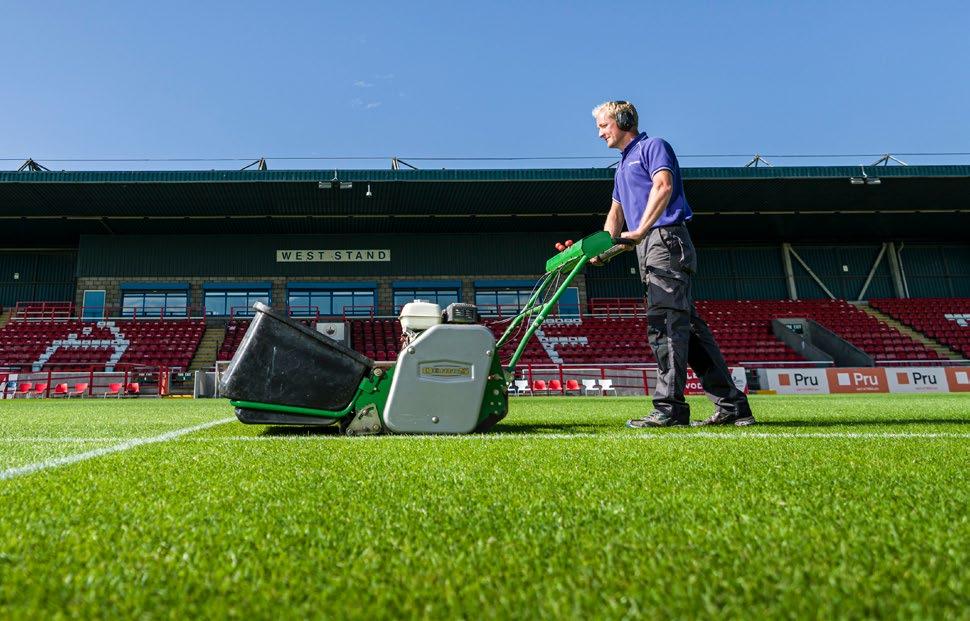
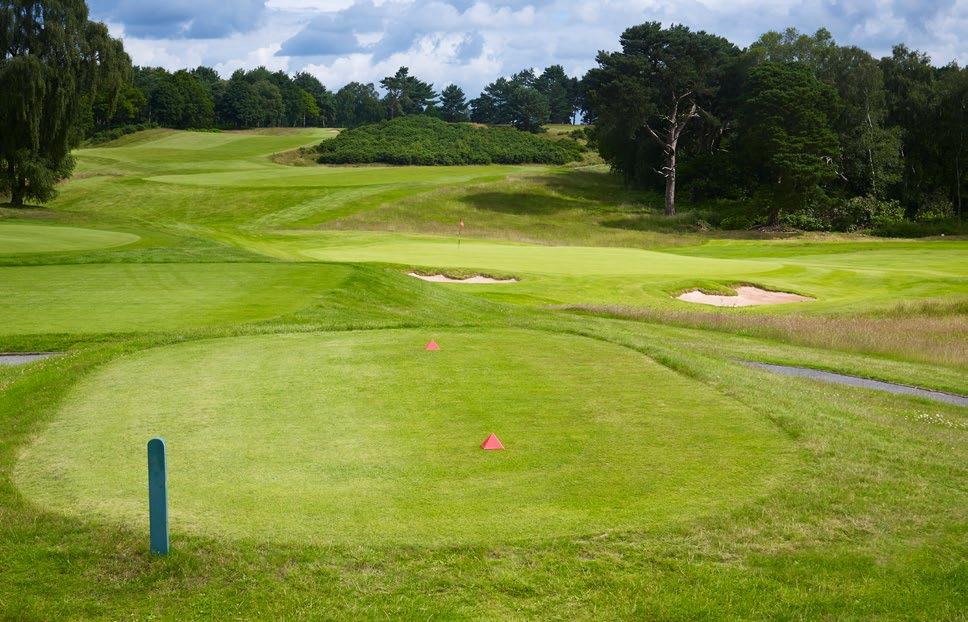
Golf mixtures 11
Sport mixtures

12
Grade ‘A’ sport mixtures
A20
Premier Ryesport
30% EUROPITCH (Perennial Ryegrass)
30% EUROSPORT (Perennial Ryegrass)
10% CHLOE (Perennial Ryegrass)
30% EUROCORDUS (Perennial Ryegrass)
• High shoot density
• Dark green in winter and summer
• A combination of fineness of leaf and a good cleanness of cut make a sward that is exceptionally easy to mow stripes
• Good disease resistance
• Good post winter recovery
Sowing rate: 35-100g/m2
Overseeding rate: 20-40g/m2
Cutting height: Down to 25mm

Sports mixtures 13
More Grade ‘A’ sport mixtures
A1
Professional Bowls
A5
Cricket, Tennis and Tees
A7
‘Olympic Quality’ Sport Ground
A9
General Outfield
A14
Racecourse and Polo Grounds
A999
Rescue
A31
Supreme Tees
A30
Rapid Sports Renovator Plus
Sowing rate: Overseeding rate: Cutting height:
35g/m2 (350kg/ha)
35g/m2 (350kg/ha)
35g/m2 (350kg/ha)
35g/m2 (350kg/ha)
35g/m2 (350kg/ha)
45g/m2 (450kg/ha)
10-15g/m2 (100-150kg/ha)
35g/m2 (350kg/ha)
20g/m2 (200kg/ha)
20g/m2 (200kg/ha)
20g/m2 (200kg/ha)
20g/m2 (200kg/ha)
20g/m2 (200kg/ha)
30g/m2 (300kg/ha) n/a
20g/m2 (200kg/ha)
Down to 4mm
Down to 4mm
Down to 10mm
Down to 20mm
Down to 20mm
Down to 35mm
Down to 3mm n/a
Scan or click here for more information on our sports mixtures.
germinalamenity.com
Sports mixtures 14
Landscaping mixtures
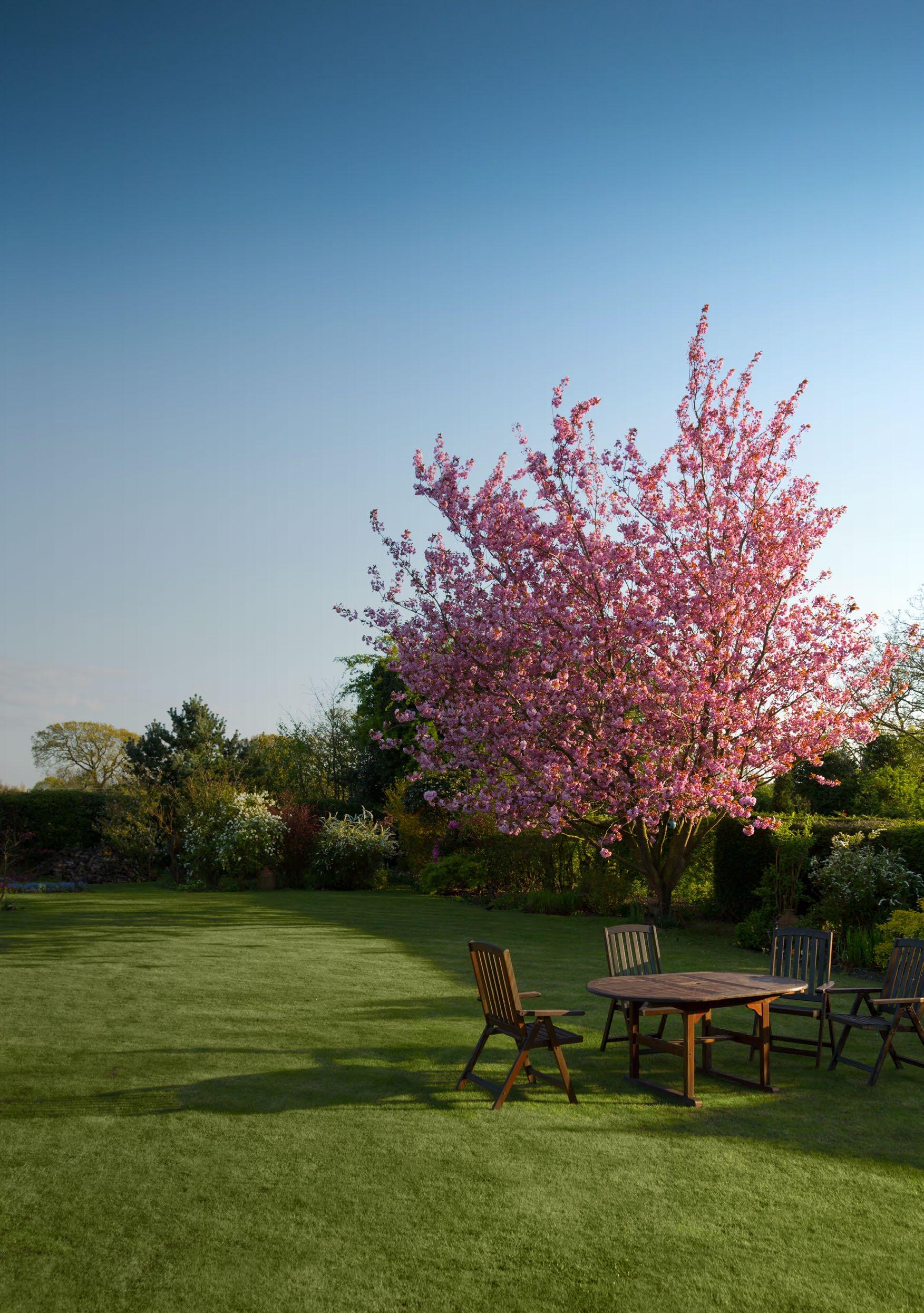
15
AberSustain
20% ABERWOLF (Perennial Ryegrass)
45% ABERFLEECE (Sheeps Fescue)
20% ABERCHARM (Slender Creeping Red Fescue)
10% ABERROYAL (Browntop Bent)
5% ABERLASTING (White Clover)
AberSustain is the first of two DoubleRoot hybrid clover mixtures launched by Germinal.
DoubleRoot hybrid clovers fix free nitrogen for companion grasses and can survive extreme weather conditions, providing a truly climate smart solution for amenity spaces.
DoubleRoot has been included in AberSustain to provide a self-sustaining, low-maintenance mixture that brings environmental benefits to parkland areas, domestic lawns, road verges, golf tees, green roofs and solar parks.
More
Grade ‘A’ landscaping mixtures
A2
Quality Lawns
A3
50g/m2 (500kg/ha)
35g/m2
A4
Low Maintenance Areas
A6
Supreme Shade
A15
Reclamation Landfill
40g/m2 (400kg/ha)
Cutting height:
Down to 6mm
Down to 15-50mm
Between 20mmuncut level
Between 25-50mm
Between 25-75mm
Embankments and Drought
50g/m2 (500kg/ha)
combining with wildflowers)
(350kg/ha) (5-10g/m2 (50-100kg/ha) when
25g/m2 (250kg/ha) 20g/m2 (200kg/ha)
20g/m2 (200kg/ha) 20g/m2 (200kg/ha) 25g/m2 (250kg/ha)
15g/m2 (150kg/ha)
Sowing rate: Overseeding rate:
Landscaping mixtures 16
More Grade ‘A’
landscaping mixtures
A16
Reclamation Country Parks
A17
Legume and Clover
A18
Road Verge and Embankments
A19
All Purpose Landscaping
A21
Saline Coastal and Road Verges
A22
Low Maintenance
A24
Wear and Tear
A25
Agricultural Reinstatement
A26
So-Green
Sowing rate: Overseeding rate:
25g/m2 (250kg/ha)
15g/m2 (150kg/ha)
2.5g/m2 (25kg/ha)
35g/m2 (350kg/ha)
50g/m2 (500kg/ha)
40g/m2 (400kg/ha)
50g/m2 (500kg/ha)
50g/m2 (500kg/ha)
8g/m2 (80kg/ha)
35g/m2 (350kg/ha)
Scan or click here more information on our landscaping mixtures.
germinalamenity.com
n/a
Cutting height:
Between 25-75mm
As required as part of other mixtures
Between 25-50mm
20g/m2 (200kg/ha)
25g/m2 (250kg/ha)
20g/m2 (200kg/ha)
20g/m2 (200kg/ha)
25g/m2 (250kg/ha) n/a
20g/m2 (200kg/ha)
Down to 20mm
Between 25-50mm
Between 20-50mm
Down to 10mm
Graze or cut as required
Down to 25mm
Landscaping mixtures 17
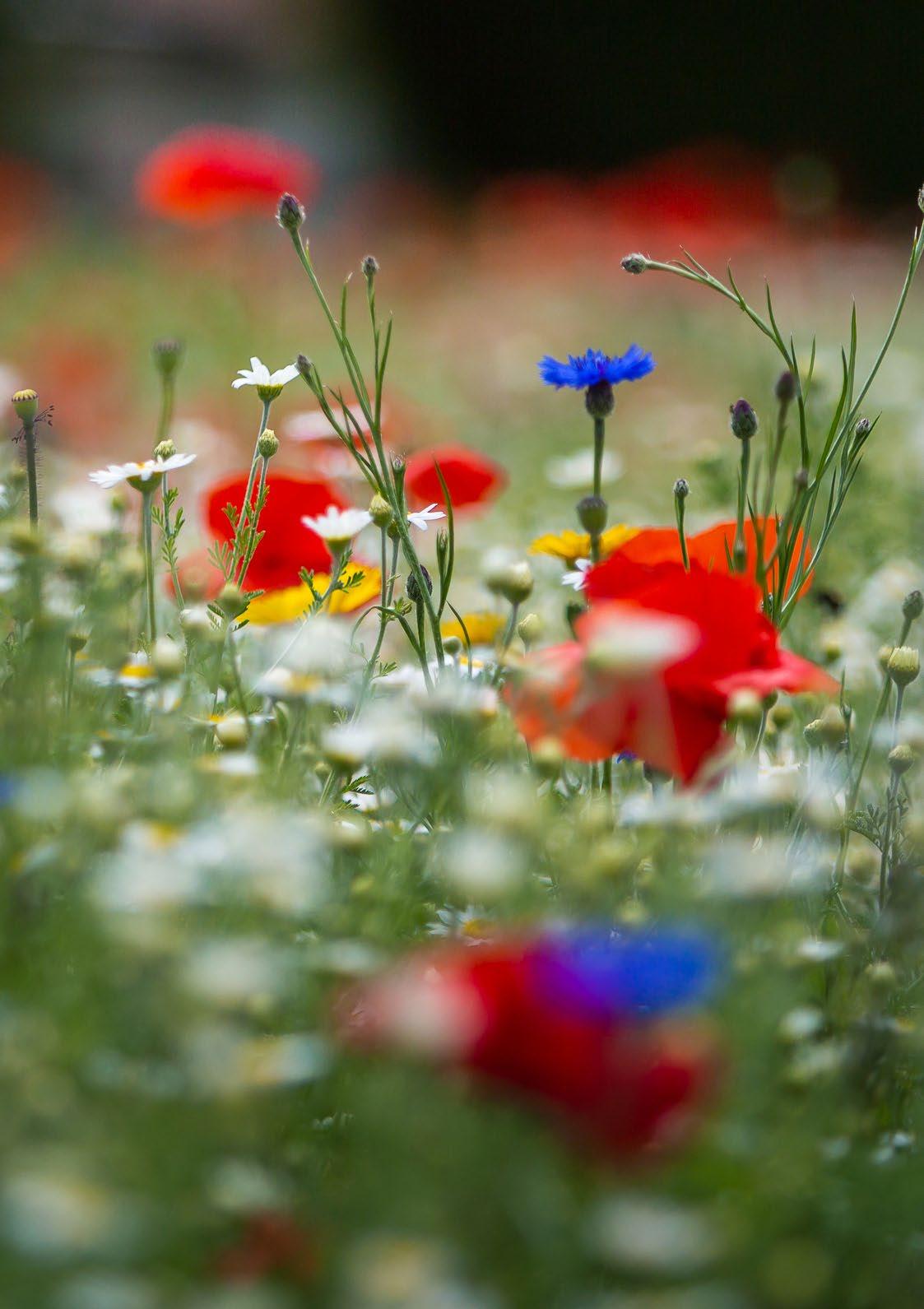
Wild flora mixtures
18
Wild sustainable beauty
As part of our commitment to improving the environmental and ecological benefit of man-made environments, our wildflower mixtures have been updated.
In addition to our UK-specific Regional Environmental (RE) mixtures, we have incorporated a selection of pollinator-friendly, non-native and ‘garden’ varieties into our general landscaping wild flora (WF and WFG) range, known as Urban Meadow.
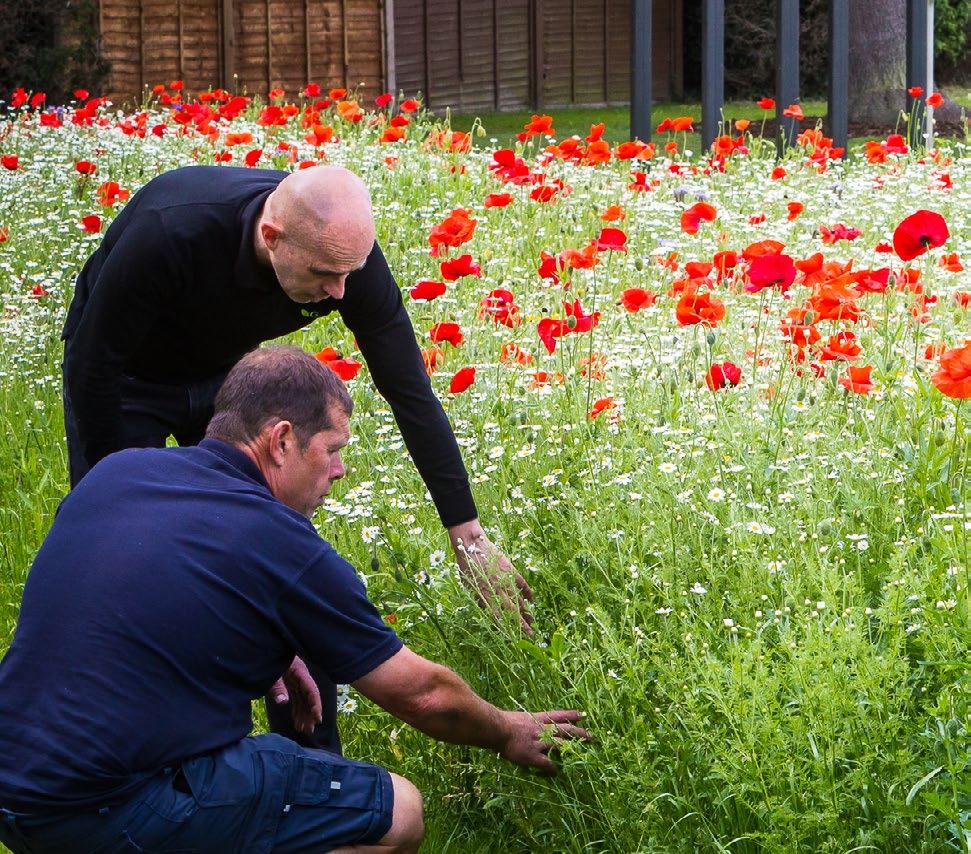
Scan or click here for more information on wildflower mixtures. germinalamenity.com 19 Wild flora mixtures
General landscaping
Urban Meadows Mixtures containing grass
WFG2
Flowering Meadow
Where to use this mixture:
Creates a meadow for most urban and suburban situations, combining the UK native wildflowers and selected non-native species found in WF1 with 80% grasses to produce a grassland meadow mixture, suitable for all soil types.
The mixture is balanced to maximise the floral interest from as early as April through to September. The inclusion of a good percentage of annuals assists in giving a first season display when the mixture is sown in March or April.
A great habitat for invertebrates which in turn provide food for birds and mammals. If possible, when cutting in late summer an area of up to one third should be left uncut until the following spring for overwintering invertebrates. This area should be alternated each year.
An 80:20 mix of grasses, annual and perennial flowers including Oxeye Daisy, Birdsfoot Trefoil, Corn poppy, Oxeye Sunflower and Echinacea.
Sowing Rate: 5g/m2

Scan or click here to view all of our wildflower mixtures. germinalamenity.com Wild flora mixtures 20
WF10 Cornfield Annuals WFG5 Calcareous Soils WF17 Cultivated Annuals WF3 General Purpose Neutral Soils WFG4 Neutral Soils WFG18 Butterfly and Honey Bee 1-5g/m2 1-5g/m2 5g/m2 1-5g/m2 5g/m2 5g/m2 1-5g/m2 WF1 Flowering Meadow Sowing rate: More urban meadow mixtures WF19 Pollinators’ Paradise WFG8 Hedgerows and Shaded Areas WFG9 Wetland and Pond Areas 5g/m2 5g/m2 WFG7 Free Draining Soils WFG6 Heavy Clay Soils WFG15 Countrylife Schools and Colleges WFG20 Eco Species Rich Lawn WFG21 Everyday Meadow 5g/m2 5g/m2 10g/m2 15g/m2 5g/m2 Scan or click here to view all of our wildflower mixtures. germinalamenity.com 1-5g/m2 Wild flora mixtures 21
Maintenance Guide
Urban Meadows
mixtures (WF and WFG)
1st cut Mid-September–1st October and collect the arisings
Cutting height 70-100mm
Maintenance thereafter
Cut from mid-August to early October. This can be done as one cut but preferably, and if the meadow is big enough, you will cut it in sections leaving a week to a fortnight between cuts. Ensure you collect the arisings. If the meadow is large enough, consider allowing up to a fifth to stand uncut through the winter and cut down and remove the clippings in March the following year. This will provide a habitat for invertebrates and some vertebrates over the winter. Rotate this area so a different section is left uncut each year. This more closely replicates the grazing of animals which would leave some small areas not grazed.
If possible and with the obvious exception of areas you are leaving uncut, lightly mow the sward down to 70-100mm as required throughout the winter months until March and collect the arisings.
Mixtures without grass (WF1, WF3 and WF19)
Cut down to 70-100mm from early-September. Remove arisings. If practical, consider leaving up to one fifth of the area uncut. The remaining dead stalks will provide a nesting and hibernation site and egg laying habitat for invertebrates over the winter. Alternate this area each winter.
If possible and with the obvious exception of areas you are leaving uncut, lightly mow the sward down to 70-100mm as required throughout the winter months until March and collect the arisings.
Mixtures of Annuals (WF10 and WF17)
These require no maintenance although over-sowing may be required in the spring each year until a sufficient seed bank has been built up.
22
100% UK Native
True Meadows
Regional Environmental (RE) mixtures
RE1 Traditional Hay Meadow (MG5
Grassland)
A grassland and wildflower community which reflects an old hay meadow before the advent of modern agricultural practises. Suitable for being managed by grazing in the long term. However, for the first few seasons managing by cutting might be required in order to develop the depth of sward to avoid excessive poaching. A great habitat for invertebrates, birds and mammals.
Where to use this mixture:
• Heavy clay soils
• Road verges
• Embankments
• Quarry areas
• Lowland areas
• To encourage insects and birds
An 80:20 mix of grasses and native wildflowers including Meadowsweet, Agrimony and Salad burnet.
Sowing Rate: 5g/m2

Wild flora mixtures 23
Scan or click here to view all of our guides on wildflower meadow management.
germinalamenity.com
More regional environmental mixtures
RE2 Lowland Meadow (MG9 Grassland)
RE3 River Flood Plain/Water Meadow (MG8 Grassland)
RE4 Lowland Limestone (CG2 Grassland)
RE8 Costal Reclamation (MG12 Grassland)
RE9 Farmland Mixture (MG6 Grassland)
RE10 Marginal Land (U20 Grassland)
RE11 Heath Scrubland (U13 Grassland)
Sowing rate:
5g/m2 5g/m2
5g/m2 5g/m2
5g/m2 5g/m2 5g/m2
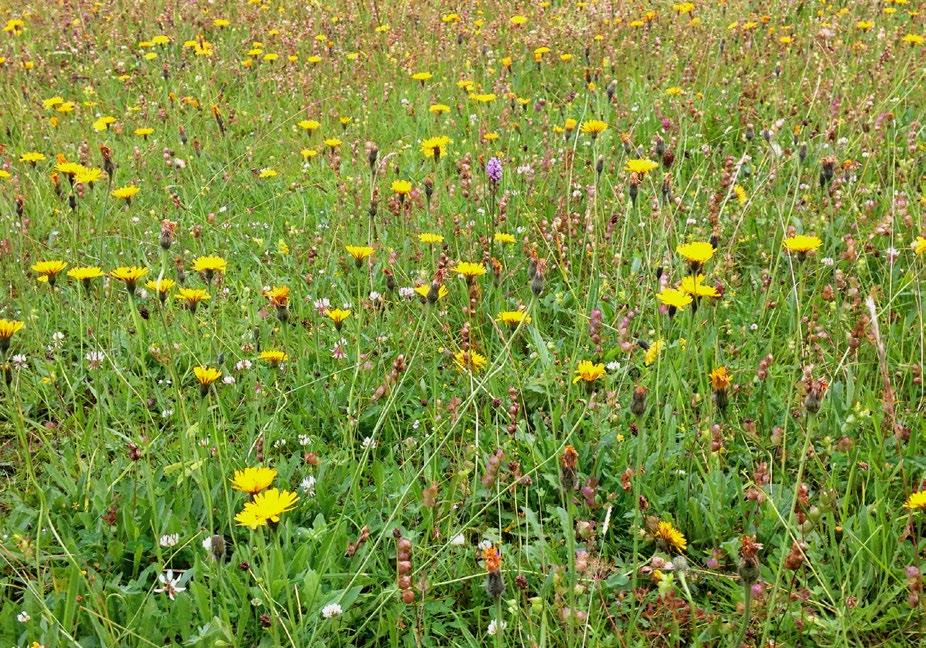
Wild flora mixtures 24
100% UK Native
Regional Environmental (RE) mixtures
Autumn sown - Year one
1st cut Early July
Repeated cuts Monthly during August, September and October
Cutting height 70-100mm
Spring sown - Year one
1st cut Mid-September–1st October and collect the arisings
Repeated cuts Monthly during August, September and October
Cutting height 70-100mm
Maintenance thereafter
Cut from mid-July to early September. This can be done as one cut but preferably, and if the meadow is big enough, you will cut it in sections leaving a week to a fortnight between cuts.
Ensure you collect the arisings. If the meadow is large enough, consider allowing up to a fifth to stand uncut through the winter and cut down and remove the clippings in March the following year. Doing this will provide a habitat for invertebrates and some vertebrates over the winter. Rotate this area so a different section is left uncut each year. This more closely replicates the grazing of animals which would leave some small areas not grazed.
If possible and with the obvious exception of areas you are leaving uncut, lightly mow the sward down to 70-100mm as required throughout the winter months until March and collect the clippings.
25
All-Ireland Wildflower mixtures
In support of the All-Ireland Pollinator Plan, our 100% Irish Native wildflower range is carefully formulated to increase biodiversity and create a habitat for thriving pollinators.
These mixtures are ideal for agricultural landscapes and for those needing to specify native wildflowers.
100% Irish Native Native wildflower mix for heavy soils
This is a popular wildflower mix suitable for most situations, from heavy clay soils to compacted new-build locations. With careful management, this mixture of annuals, biennials and perennials will mature over the years to produce a diverse and attractive meadow supporting a rich habitat.
Where to use this mixture:
• Heavy clay soils
• Road verges
• Embankments
• New builds
• Soils with a pH below 6.5
Sowing rate: 1-2g/m²
Alternative option
A 60:40 mix of native wildflowers and grasses can be specified to create a grassland meadow and wildflower community with these mixes. These wildflowers produce an ideal habitat for invertebrates, birds and mammals.
Sowing rate: 5g/m²
Wild flora mixtures 26
Native wildflower mix for light soils
A beautiful wildflower mixture for well-drained light or sandy soils, with a pH range of 5.5-7.5. This mixture of annuals, biennials and perennials includes Oxeye daisy, Cornflower and Yellow Rattle. With a well-balanced flowering interest, this mixture attracts butterflies and bees.
Where to use this mixture:
• Light sandy soils
• Coastal lowlands
• Quarry areas
• To encourage insects and birds
Sowing rate: 1-2g/m²
Native wildflower mix of cornfield annuals
This mixture of cornfield annuals creates an outstanding display of colour in its first year, either sown alone or to supplement a mix of perennial species which are slower to establish. Including Cornflower, Corncockle, Marigold and Poppy, this mix will flower within six to ten weeks of sowing.
Where to use this mixture:
• New gardens
• School projects
• One-time annual display
• Supplement to perennial wildflower mix
Sowing rate: 1-5g/m²
Wild flora mixtures 27

Fertilisers
28
Specialist fertilisers
Trace elements: Granule size: Spreading rate: Period of usage: Specialist fertilisers
G13 ProteKt 3-0-22 (+3% Fe) n/a 1.0-2.0mm 35g/m2 All year
G14 Alleviate Fe 4-0-10 (+ 8%Fe)
Agrosil® LR 0-20-0 (+20% Silicate)
Easygreen Mini 12-12-17 (+3MgO)
Fertilis Swing NK 14-0-19 (+2% MgO + TE)
All above bag sizes are 25kg
*Top dressing turf 50g/m2
Manganese n/a
Boron
Iron
Zinc
0.5-1.0mm 1.0-2.0mm 1.0-2.5mm
35g/m2 All year
50g/m2* 80g/m2** 100-120g/m2*** 35g/m2**** 35g/m2
All year
FebruaryOctober
Boron
Iron 0.5-1.5mm 30g/m2
**Top dressing turf and brushing with aeration / core holes 80g/m2
***Applying under turf 100-120g/m2
****Applying at time of seeding 35-50g/m2
Scan or click here for more information on our fertiliser range.
germinalamenity.com
FebruarySeptember
Fertilisers 29
Slow release fertilisers
GSR TRI-PHASE
18-3.5-8 (+1Mgo+TE)
Trace elements:
Copper, zinc, boron, managnese and molybdenum
Granule size: 1.0-2.0mm
Spreading rate: 25-35g/m2
Period of usage: March-September

An organic based phased release fertiliser that provides a consistent release of nitrogen and potash over a period of five months.
Quick release N gives way to methylene urea followed by a final release from the organic based element. Slow release potash from Kali vinasse helps regulate the water, as well as the intake and movement of nutrients around the plant.
This is essential to reduce plant stress and enhance drought resistance. GSR Tri-Phase is perfect for sports fields, golf fairways, golf tees and all amenity areas.
• 16 - 20 week release period
• Mini and max granule option
• Phased release ensures uniform feeding across the period of use
• Slow release potash aids plant health and drought resistance
Fertilisers 30
More slow release fertilisers
NovaTec Premium 15-3-20 (+2% MgO + TE)
NovaTec Classic 12-8-16 (+3% MgO + TE)
Winter Booster 5-3-20 (+1FE)
All above bag sizes are 25kg
Trace elements: Granule size: Spreading rate: Period of usage:
Boron
Iron
Zinc 2.0-4.0mm 20-35g/m2
Boron
Iron
Zinc n/a
2.0-4.0mm 2.0-4.0mm
FebruaryNovember
20-35g/m2
FebruaryNovember 70g/m2 All year
Scan or click here for more information on our fertiliser range.
germinalamenity.com
Fertilisers 31
Liquid fertilisers
GL6 9-4-6
TE + SW + Humic
Application rate: 30L per Ha
Recommended every 7-10 days
Pack size: 20L
Period of usage: All year for sports (March–October for fine turf)
GL6 is the perfect nutritional companion for creeping bentgrass.
A complete formulation aimed at spoon feeding creeping bent plants exactly what they need to stay healthy and cope with abiotic stress.
• A readily available nitrogen source of ammonium nitrate as recommended by US creeping bent plant breeders
• Low applications for close control and exacting management
• 20lts per hectare provides 2.3kg of Nitrogen
• Safe for use post seeding and throughout the growing season
Fertilisers 32
More liquid fertilisers
Liquid Chelated Iron 8% Fe
Fighter Commando Phosphite 0-28-26
Vitanica RZ 0-28-26
Ammonia / Urea based
GL1 15-3-3 + Te (Iron, Manganese)
GL2 3-6-6 + 1Fe
GL3 20-0-10 + Seaweed + Humic
GL4 16-3-10
GL5 12-0-6 + 1Fe
Pack size: Application rate: Period of usage:
10-30L per Ha (min 200-400L of water per Ha) 30L per Ha 30L
All year
5L per Ha at 3-4 week intervals 10-30L per Ha
March-October March-October
March-October (fine turf)
All year for sports
March-October (fine turf)
All year for sports
March-October (fine turf)
All year for sports
March-October (fine turf)
All year for sports
March-October (fine turf)
All year for sports
33
10L 10L 20L 20L 20L
30L
30L per Ha 30L per Ha
per Ha
10L 20L 20L
per Ha
Fertilisers
Seaweed
based feeds
Maritime Turf Hardener 2-4-4 + 4fe
Maritime + Nitrogen 15-0-0
Maritime + Iron 4Fe
Maritime Natural 30
Scan
germinalamenity.com
Period of usage:
20-40L per Ha in 400-600L of water
40L per Ha in 400-600L of water
40L per Ha in 400-600L of water
40L per Ha in 400-600L of water
Every 4-6 weeks
Every 4-6 weeks
Every 4-6 weeks
Every 4-6 weeks
Pack size: Application rate:
10L 10L 10L 10L
or click here more information on our fertiliser range.
34
Compound fertilisers
Pre-seeding
G1 Quick Start
6-9-6
Granule size: 2.0-4.0mm
Pack size: 25kg
Spreading rate: 70g/m2
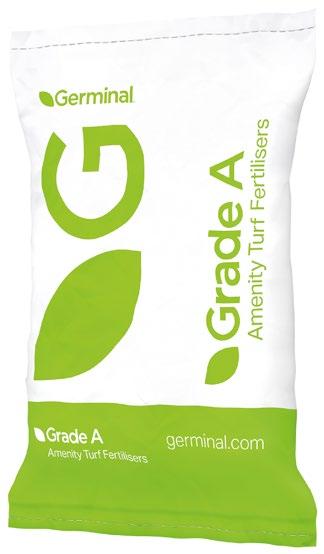
The standard analysis for use as a pre-seed dressing for the establishment of seed on both outfield and fine turf areas.
• The industry standard pre-seeding fertiliser
• High phosphate levels to instantly aid root growth and accelerate seedling establishment
• Levels of potassium help strengthen the leaf blade of new seedlings and help them fight foliar disease such as pythium diseases
Scan or click here for more information on our fertiliser range. germinalamenity.com Fertilisers 35
More compound fertilisers
Pre-seeding Spring/Summer
Autumn/Winter
G2 Quick Start Extra 10-15-10
G3 Spring kick 12-6-6
G4 Fine Turf 11-5-5
G5 Booster 9-7-7
G6 Booster Extra 20-10-10
G9 Fine Turf Iron Booster 12-3-9 +2Fe +0.5Mg
G10 Labour Saver Weed, feed and moss killer 10-2-1.7 +8Fe
G7 Bio Builder 5-3-8 +8CaO+0.5Mg
G8 Winter Defence 3-12-12
G12 Fine Turf Autumn Tonic 3-6-8 +4Fe
G15 Fine Turf Winter Defence 3-10-5
Granule size: Spreading rate:
All above pack sizes are 25kg with the exception of G10 Labour Saver which is 20kg
2.0-4.0mm 2.0-4.0mm 2.0-4.0mm 1.0-1.4mm 0.5mm 1.0-2.0mm 70g/m2 70g/m2 70g/m2 35g/m2 70g/m2 70g/m2
2.0-4.0mm 0.5-1.5mm 2.0-4.0mm 0.5-1.5mm 0.5-1.5mm 70g/m2 70g/m2 70g/m2 70g/m2 70g/m2
Fertilisers 36
Territory map
Sales Representatives
Scotland and North East England
Stuart Tait
Technical Sales Representative
07887 578 802
stuart.tait@germinal.com
South Wales, South Midlands and South West
Alex Beesley
Technical Sales Representative
07795 416 391
alex.beesley@germinal.com
South and Eastern England
Sandy Pentecost
Technical Sales Representative
07887 578 804
sandy.pentecost@germinal.com
North West England, North Wales
West Yorkshire and Midlands
Paul Moreton
Technical Sales Representative
07887 578 807
paul.moreton@germinal.com
Ireland and Northern Ireland
Graham Parker
Technical Sales Representative
+353 (0) 87 608 6048
graham.parker@germinal.com
UK and Ireland
Richard Brown
Amenity Director
07887 578 805
richard.brown@germinal.com
Scotland and North East England South and Eastern England South Wales South Midlands South West North West England North Wales The Midlands Ireland Northern Ireland
37 Territory map

Should you require any more information, or to request a selection of free brochures and technical guides, please visit our website: germinalamenity.com @GerminalAmenity Aber® and DoubleRoot® are registered trademarks of Openfolde Ltd. The mixtures in this brochure are correct at the time of going to press and the supplies of the varieties used in the mixtures should be adequate for this season. If, however, we do run short of some, they will be replaced by the next best variety on the Recommended List. Find out more
Germinal GB Limited
Camp Road
Witham St. Hughs
Lincoln LN6 9QJ
T: +44 (0) 1522 868714
lincoln@germinalamenity.com
Germinal is committed to an environmentally sustainable future. This brochure is made from entirely bio-degradable products. Please recycle this brochure.

































